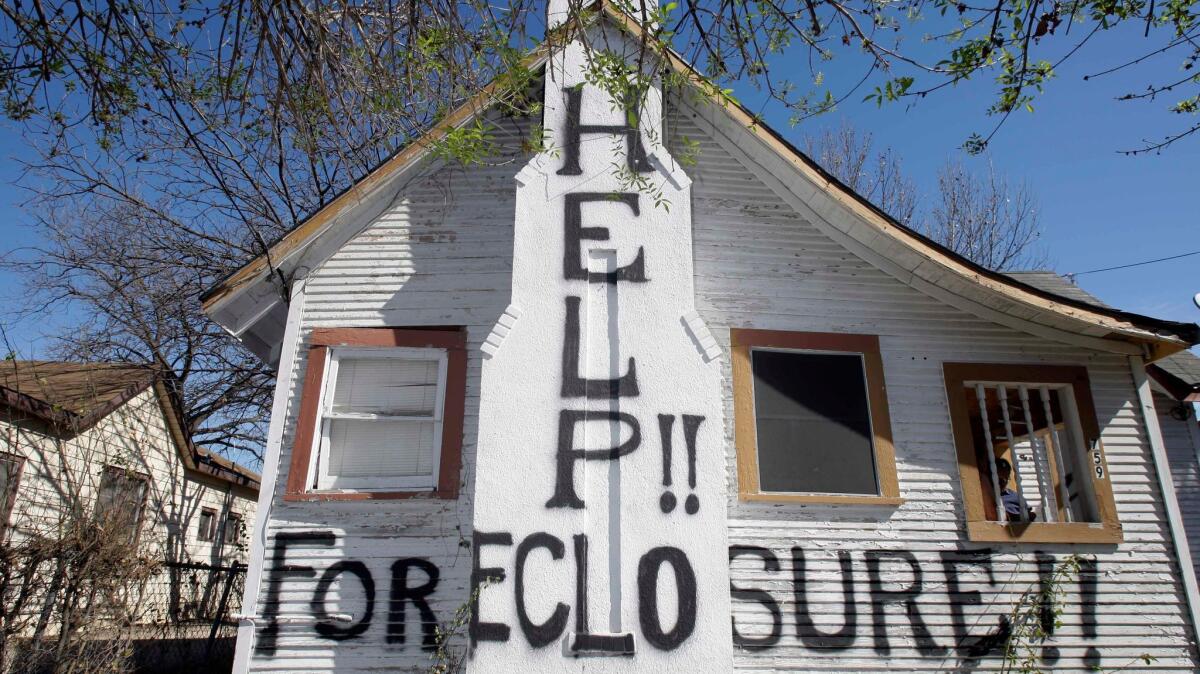Obama’s foreclosure prevention program has helped far fewer homeowners than expected

- Share via
When the Obama administration announced a massive effort to help distressed homeowners in 2009, it set high expectations. The program, government officials said, would keep up to 4 million borrowers out of foreclosure.
“It will give millions of families resigned to financial ruin a chance to rebuild,” Obama said at a event announcing the effort. “By bringing down the foreclosure rate, it will help shore up housing prices for everyone.”
Six years later, Obama is preparing to leave office, and the Home Affordable Modification Program, or HAMP, accepted its final applications Friday having helped a fraction of the homeowners government officials initially expected. About 1.6 million borrowers have seen their mortgage payments lowered through the program so far, but about a third of those people eventually fell behind on their payments again.
“The president set out an ambitious goal that wasn’t met,” said Kevin Stein, deputy director of the California Reinvestment Coalition, a housing advocacy group. “It was definitely a step forward and step in the right direction, but ... a lot of people ended up falling through the cracks.”
HAMP is one of the last remnants of the $700-billion taxpayer bailout effort, known as the Troubled Asset Relief Program, or TARP, put in place during the financial crisis. About $28 billion of that money was carved out to help distressed homeowners by paying banks to lower their interest rates and monthly payments.
It was launched in the midst of one of the deepest housing crises in U.S. history. Millions of people had taken out subprime loans that they could no longer afford, sending foreclosure rates to record levels.
The Obama administration set out to save more homeowners from foreclosure, but the effort has been bedeviled by complaints that banks repeatedly lost homeowners’ paperwork or incorrectly told them they didn’t qualify for help. The Treasury Department didn’t act quickly enough to force banks to abide by the rules of the program, housing advocates have said. Nearly 70% of the homeowners who applied for the program were rejected, according to government data.
A 2014 government report examined the record of four large mortgage servicers and found that black and Latino borrowers were denied entry into the program at a “significantly higher” rate. “Borrowers in substantially minority areas had at least 3% higher denial rates than their comparison populations of borrowers in nonsubstantially minority areas,” according to the Government Accountability Office. “Statistical differences in outcomes among population groups might suggest potential fair lending concerns that merit further examination.”
The banking industry has defended its performance, noting that some of the money it receives through HAMP is passed on to investors and borrowers, who receive incentives for paying their mortgages on time. HAMP was a complicated program, industry executives have said, and it took time to develop a protocol for judging when a borrower should qualify and how much help to give them.
Many of the program’s early problems reflect its complexity, said Justin Wiseman, director of loan administration policy at the Mortgage Bankers Assn., an industry group. “It’s incredibly difficult to design a program in the midst of a crisis,” he said. In the end, he said, HAMP “did help millions of homeowners and created awareness” about the availability of loan modifications.
Even critics of the program say that despite falling short of expectations, HAMP forced the banking industry to change its approach toward distressed borrowers. Before the program, banks all had different approaches to helping borrowers who were behind on their mortgage payments. Some simply added a homeowner’s overdue amount to their current payments, increasing rather than lowering the payments. Others refused to discuss helping a borrower until they were 90 days delinquent.
“It was really the wild, wild West,” Stein said.
The government program lifted industry standards and set common expectations that banks adopted even when operating outside HAMP, said Alys Cohen, staff attorney for the National Consumer Law Center. “Many homeowners got similar types of modifications directly through their mortgage company, and those were modeled on the HAMP program,” Cohen said.
About 1 million borrowers currently have HAMP loan modifications, which typically lower their payments about $500 a month. The program, originally scheduled to expire in 2012, was extended three times.
The program “changed how mortgage servicers handled homeowners in distress, not only by developing a template for loan modifications focused on affordability but also by creating and enforcing standards of care that have been widely adopted by the entire industry,” a Treasury spokesman said.
The program was expanded over time to include helping lowering how much homeowners owed in some cases in addition to lowering their payments, and to help people who are unemployed, a Treasury Department official noted.
Another part of Obama’s foreclosure prevention effort, the Home Affordable Refinance Program, has also been repeatedly extended as it struggled to reach as many people as initially hoped.
That program allows people who owe more than their home is worth, known as being “underwater,” to refinance into a loan at a lower interest rate. So far, about 3 million homeowners have used that program, which is scheduled to expire in September. The Obama administration initially expected up to 5 million.
For the Office of the Special Inspector General for the Troubled Asset Relief Program, the chief watchdog of the financial crisis-era bailouts, the end of the HAMP application process doesn’t diminish its worries. Banks will continue to receive billions in incentive payments for helping borrowers who signed up for HAMP for seven years. Wells Fargo, which has received $1.8 billion through the program, is eligible for up to $1.5 billion in bailout funds over the next seven years, for example. JPMorgan and Bank of America, which have received $1.9 billion and $1.4 billion, respectively, could receive about $1 billion each over the next few years.
Many of these banks have repeatedly broken the rules of the program, including kicking homeowners out unfairly or making it too difficult to apply for the help, according to the agency.
“While HAMP did not live up to expectations, the most important thing going forward is to protect from fraud, waste and abuse the nearly 1 million people with lowered interest rates in the program and the billions of dollars Treasury will continue to pay to mortgage servicers,” said Christy Goldsmith Romero, special inspector general for TARP.
Merle writes for the Washington Post.
More to Read
Inside the business of entertainment
The Wide Shot brings you news, analysis and insights on everything from streaming wars to production — and what it all means for the future.
You may occasionally receive promotional content from the Los Angeles Times.










